Selection of (Green) Roof Systems: A Sustainability-Based Multi-Criteria Analysis
Abstract
:1. Introduction
2. Methodology
- (1)
- Identification of the factors influencing the choice between a traditional flat solution and a green roof system (Figure 1), to define the main criteria and sub-criteria considered;
- (2)
- Application of a multi-criteria technique—the Analytic Hierarchy Process (AHP) [23]—in order to evaluate the priority of each selected criteria and sub-criteria;
- (3)
- Final ranking of green roofs and traditional roofs according to the full set of criteria and sub-criteria.
2.1. Selection of Criteria
- (1)
- Economic
- (2)
- Environmental
- (3)
- Social
- (4)
- Performance
2.2. Economic Criteria
2.2.1. Installation Costs
2.2.2. Maintenance Costs
2.2.3. Tax Incentives
2.2.4. Real Estate Benefits
2.2.5. Energy Savings
2.3. Environmental Criteria
2.3.1. Air Quality and Urban Heat Island Reduction
2.3.2. Runoff Reduction
2.3.3. Embodied Energy and Carbon Emission
2.3.4. Resource Sustainability
2.4. Social
2.4.1. Building Aesthetic
2.4.2. Urban Aesthetic
- -
- green spaces located at high altitude with panoramic views of the surrounding urban environment;
- -
- spaces where plants and plant species are cultivated, even edible plants, and it is possible to observe animal species (e.g., birds);
- -
- social gathering and meeting spaces (especially in the presence of cafes, restaurants, etc.).
2.4.3. Suitability to Urban Location
2.4.4. Health
2.5. Performance
2.5.1. Roof Longevity
2.5.2. Acoustic Noise Reduction
2.5.3. Weight of System
2.5.4. Insulation Properties
3. Multi-Criteria Analysis—The Analytic Hierarchy Process (AHP)
- -
- First level: the goal to be achieved, i.e., identifying a better roof system solution;
- -
- Second level: criteria, i.e., the significant factors considered for the selection of the better solution (i.e., Economic, Environmental, Social, Performance);
- -
- Third level: sub-criteria (or groups of sub-criteria), which specify the upper criteria (i.e., the 17 sub-criteria);
- -
- Fourth level: the alternative solutions that allow the goal to be reached (i.e., the two alternative roof solutions).
3.1. The Weighing of the Criteria and Sub-Criteria
4. Results and Discussion
4.1. Criteria and Sub-Criteria Priority
4.2. Final Ranking
5. Conclusions
Author Contributions
Funding
Acknowledgments
Conflicts of Interest
References
- Wong, N.H.; Tay, S.F.; Wong, R.; Ong, C.L.; Sia, A. Life cycle cost analysis of rooftop gardens in Singapore. Build. Environ. 2003, 38, 499–509. [Google Scholar] [CrossRef]
- Bianchini, F.; Hewage, K. How ‘green’ are the green roofs? Lifecycle analysis of green roof materials. Build. Environ. 2012, 48, 57–65. [Google Scholar] [CrossRef]
- Claus, K.; Rousseau, S. Public versus private incentives to invest in green roofs: A cost benefit analysis for Flanders. Urban For. Urban Green. 2012, 11, 417–425. [Google Scholar] [CrossRef]
- Rosato, P.; Valcovich, E.; Stival, C.A.; Berto, R.; Cechet, G. Horizontal extensive green roofs in existing buildings. Part one—Technological feature. Valori e Valutazioni 2015, VIII, 29–44. [Google Scholar]
- Rosato, P.; Valcovich, E.; Stival, C.A.; Berto, R.; Cechet, G. Horizontal extensive green roofs in existing building. Part two—Economic features. Valori e Valutazioni 2016, IX, 5–27. [Google Scholar]
- Coma, J.; Pérez, G.; Cabeza, L.F. Chapter 4.8—Life Cycle Assessment of Green Roofs. In Nature Based Strategies for Urban and Building Sustainability; Pérez, G., Perini, K., Eds.; Butterworth-Heinemann: Oxford, UK, 2018; pp. 341–351. [Google Scholar]
- Perini, K.; Rosasco, P. Is greening the building envelope economically sustainable? An analysis to evaluate the advantages of economy of scope of vertical greening systems and green roofs. Urban For. Urban Green. 2016, 20, 328–337. [Google Scholar] [CrossRef]
- Coma, J.; Pérez, G.; Cabeza, L.F. Chapter 3.2—Green Roofs to Enhance the Thermal Performance of Buildings and Outdoor Comfort. In Nature Based Strategies for Urban and Building Sustainability; Pérez, G., Perini, K., Eds.; Butterworth-Heinemann: Oxford, UK, 2018; pp. 109–117. [Google Scholar]
- Clark, C.; Talbot, B.; Bulkley, J.; Adriaens, P. Optimization of green roofs for air pollution mitigation. In Proceedings of the Third North American Green Roof Conference: Greening Rooftops for Sustainable Communities, Washington, DC, USA, 4–6 May 2005; pp. 482–497. [Google Scholar]
- Peck, S.W.; Callaghan, C.; Kuhn, M.E.; Bass, B. Greenbacks from Green Roofs: Forging a New Industry in Canada; Status Report on Benefits, Barriers and Opportunities for Green Roof and Vertical Garden Technology Diffusion; Environmental Adaptation Research Group: Toronto, ON, Canada, 1999. [Google Scholar]
- Van Renterghem, T. Chapter 3.8—Green Roofs for Acoustic Insulation and Noise Reduction. In Nature Based Strategies for Urban and Building Sustainability; Pérez, G., Perini, K., Eds.; Butterworth-Heinemann: Oxford, UK, 2018; pp. 167–179. [Google Scholar]
- Hashemi, S.S.G.; Mahmud, H.B.; Ashraf, M.A. Performance of green roofs with respect to water quality and reduction of energy consumption in tropics: A review. Renew. Sustain. Energy Rev. 2015, 52, 669–679. [Google Scholar] [CrossRef]
- Rowe, B. Chapter 3.5—Green Roofs for Pollutants’ Reduction. In Nature Based Strategies for Urban and Building Sustainability; Pérez, G., Perini, K., Eds.; Butterworth-Heinemann: Oxford, UK, 2018; pp. 141–148. [Google Scholar]
- Rosenzweig, C.; Solecki, W.D.; Slosberg, R.B. Mitigating New York City’s Heat Island with Urban Forestry, Living Roofs, and Light Surfaces; New York City Regional Heat Island Initiative; New York State Energy Research and Development Authority (NYSERDA): New York City, NY, USA, 2006.
- Oke, R.T. The Energetic Basis of the Urban Heat Island. Q. J. R. Meteorol. Soc. 1982, 108, 1–24. [Google Scholar] [CrossRef]
- Tan P., Y.; Sia, A. A pilot green roof research project in Singapore. In Proceedings of the Third Annual Greening Rooftops for Sustainable Communities Conference, Toronto, ON, Canada, 4–6 May 2005. [Google Scholar]
- Bianchini, F.; Hewage, K. Probabilistic social cost-benefit analysis for green roofs: A lifecycle approach. Build. Environ. 2012, 58, 152–162. [Google Scholar] [CrossRef]
- Dunnett, N.; Kingsbury, N. Planting Green Roofs and Living Walls; Timber Press: Portland, OR, USA, 2008. [Google Scholar]
- Breuning, J.; Yanders, A.C. FLL Guidelines for the Planning, Construction and Maintenance of Green Roofing; EV-FLL: Bonn, Germany, 2008; p. 9. [Google Scholar]
- Šaparauskas, J.; Zavadskas, E.K.; Turskis, Z. Selection of facade’s alternatives of commercial and public buildings based on multiple criteria/Komercinės ir viešosios paskirties pastatų fasado alternatyvų daugiakriterinė atranka. Int. J. Strateg. Prop. Manag. 2011, 15, 189–203. [Google Scholar] [CrossRef]
- Sangkakool, T.; Techato, K.; Zaman, R.; Brudermann, T. Prospects of green roofs in urban Thailand—A multi-criteria decision analysis. J. Clean. Prod. 2018, 196, 400–410. [Google Scholar] [CrossRef]
- Nadoushani, Z.S.M.; Akbarnezhad, A.; Jornet, J.F.; Xiao, J. Multi-criteria selection of façade systems based on sustainability criteria. Build. Environ. 2017, 121, 67–78. [Google Scholar] [CrossRef]
- Saaty, T.L. How to make a decision: The analytic hierarchy process. Eur. J. Oper. Res. 1990, 48, 9–26. [Google Scholar] [CrossRef]
- City of Portland. Cost Benefit Evaluation of Ecoroofs; City of Portland: Portland, OR, USA, 2008.
- Saiz, S.; Kennedy, C.; Bass, B.; Pressnail, K. Comparative Life Cycle Assessment of Standard and Green Roofs. Environ. Sci. Technol. 2006, 40, 4312–4316. [Google Scholar] [CrossRef] [PubMed]
- Acks, K. A Framework of Green Roof Cost-Benefit Analysis: Initial Estimates. In Green Roofs in the New York Metropolitan Region; Rosenzweig, C., Gaffin, S., Parshall, L., Eds.; NASA/Goddard Institute for Space Studies and Columbia University, Center for Climate Systems Research: New York City, NY, USA, 2006; p. 59. [Google Scholar]
- Francois, D.R.; Theriault, M.; Kestens, Y.; Villeneuve, P. Landscaping and house values: An empirical investigation. J. Real Estate Res. 2002, 23, 139–161. [Google Scholar]
- Tomalty, R.; Komorowski, B.; Doiron, D. The Monetary Value of the Soft Benefits of Green Roofs—Final Report; Smart Cities Research Services: Montreal, QC, Canada, 2010. [Google Scholar]
- Kotsiris, G.; Androutsopoulos, A.; Polychroni, E.; Nektarios, P.A. Dynamic U-value estimation and energy simulation for green roofs. Energy Build. 2012, 45, 240–249. [Google Scholar] [CrossRef]
- Perini, K.; Ottelé, M.; Giulini, S.; Magliocco, A.; Roccotiello, E. Quantification of fine dust deposition on different plant species in a vertical greening system. Ecol. Eng. 2017, 100, 268–276. [Google Scholar] [CrossRef]
- Speak, A.F.; Rothwell, J.J.; Lindley, S.J.; Smith, C.L. Urban particulate pollution reduction by four species of green roof vegetation in a UK city. Atmos. Environ. 2012, 61, 283–293. [Google Scholar] [CrossRef]
- Currie, B.A.; Bass, B. Estimates of air pollution mitigation with green plants and green roofs using the UFORE model. Urban Ecosyst. 2008, 11, 409–422. [Google Scholar] [CrossRef]
- Getter, K.L.; Rowe, D.B.; Robertson, G.P.; Cregg, B.M.; Andresen, J.A. Carbon Sequestration Potential of Extensive Green Roofs. Environ. Sci. Technol. 2009, 43, 7564–7570. [Google Scholar] [CrossRef]
- Whittinghill, L.J.; Rowe, D.B.; Schutzki, R.; Cregg, B.M. Quantifying carbon sequestration of various green roof and ornamental landscape systems. Landsc. Urban Plan. 2014, 123, 41–48. [Google Scholar] [CrossRef]
- Scherba, A.; Sailor, D.J.; Rosenstiel, T.N.; Wamser, C.C. Modeling impacts of roof reflectivity, integrated photovoltaic panels and green roof systems on sensible heat flux into the urban environment. Build. Environ. 2011, 46, 2542–2551. [Google Scholar] [CrossRef]
- Akbari, H.; Pomerantz, M.; Taha, H. Cool surfaces and shade trees to reduce energy use and improve air quality in urban areas. Sol. Energy 2001, 70, 295–310. [Google Scholar] [CrossRef]
- Palla, A.; Gnecco, I. Chapter 3.11—Green Roofs to Improve Water Management. In Nature Based Strategies for Urban and Building Sustainability; Pérez, G., Perini, K., Eds.; Butterworth-Heinemann: Oxford, UK, 2018; pp. 203–213. [Google Scholar]
- Fioretti, R.; Palla, A.; Lanza, L.G.; Principi, P. Green roof energy and water related performance in the Mediterranean climate. Build. Environ. 2010, 45, 1890–1904. [Google Scholar] [CrossRef]
- Berndtsson, J.C. Green roof performance towards management of runoff water quantity and quality: A review. Ecol. Eng. 2010, 36, 351–360. [Google Scholar] [CrossRef]
- Poë, S.; Stovin, V.; Berretta, C. Parameters influencing the regeneration of a green roof’s retention capacity via evapotranspiration. J. Hydrol. 2015, 523, 356–367. [Google Scholar] [CrossRef]
- Palla, A.; Gnecco, I.; Lanza, L.G. Compared performance of a conceptual and a mechanistic hydrologic models of a green roof. Hydrol. Process. 2012, 26, 73–84. [Google Scholar] [CrossRef]
- Azari, R.; Abbasabadi, N. Embodied energy of buildings: A review of data, methods, challenges, and research trends. Energy Build. 2018, 168, 225–235. [Google Scholar] [CrossRef]
- Langston, C. Green Roof Evaluation: A Holistic ‘Long Life, Loose Fit, Low Energy’ Approach. Constr. Econ. Build. 2015, 15, 76–94. [Google Scholar] [CrossRef]
- Agra, H.; Klein, T.; Vasl, A.; Kadas, G.; Blaustein, L. Measuring the effect of plant-community composition on carbon fixation on green roofs. Urban For. Urban Green. 2017, 24, 1–4. [Google Scholar] [CrossRef]
- Kotzen, B. Chapter 4.2—Green Roofs Social and Aesthetic Aspects. In Nature Based Strategies for Urban and Building Sustainability; Pérez, G., Perini, K., Eds.; Butterworth-Heinemann: Oxford, UK, 2018; pp. 273–281. [Google Scholar]
- Feng, H.; Hewage, K.N. Chapter 4.5—Economic Benefits and Costs of Green Roofs. In Nature Based Strategies for Urban and Building Sustainability; Pérez, G., Perini, K., Eds.; Butterworth-Heinemann: Oxford, UK, 2018; pp. 307–318. [Google Scholar]
- Sabbion, P. Chapter 4.3—Green Streets Social and Aesthetic Aspects. In Nature Based Strategies for Urban and Building Sustainability; Pérez, G., Perini, K., Eds.; Butterworth-Heinemann: Oxford, UK, 2018; pp. 283–290. [Google Scholar]
- World Health Organization (WHO). Health Risks of Air Pollution in Europe—HRAPIE Project; World Health Organization: Copenhagen, Denmark, 2013. [Google Scholar]
- Wilson, E.O. Biophilia; Harvard University Press: Cambridge, MA, USA, 1984. [Google Scholar]
- Giulio, R.D. Manuale di manutenzione edilizia. In Valutazione del Degrado e Programmazione della Manutenzione, 3rd ed.; Maggioli Editore: Rimini, Italy, 2007. [Google Scholar]
- Kosareo, L.; Ries, R. Comparative environmental life cycle assessment of green roofs. Build. Environ. 2007, 42, 2606–2613. [Google Scholar] [CrossRef]
- Connelly, M.; Hodgson, M. Experimental investigation of the sound absorption characteristics of vegetated roofs. Build. Environ. 2015, 92, 335–346. [Google Scholar] [CrossRef]
- Nilsson, M.; Bengtsson, J.; Klæboe, R. Environmental Methods for Transport Noise Reduction, 2015th ed.; CRC Press, Taylor & Francis Group: Boca Raton, FL, USA, 2015. [Google Scholar]
- Hooker, J.; Hendriks, N. The Green Roofs of Europe. In Proceedings of the 107th Annual Convention and Exibit of the National Roofing Contractors Association; The International Waterproofing Association: San Francisco CA, USA, 1994. [Google Scholar]
- WTCB. Groendak (Green Roof). Technische Voorlichting (Technical Advice)-229; Wetenschappelijk en Technisch Centrum voor het Bouwbedrijf (Belgian Building Research Institute): Bruxelles, Belgium, 2006. [Google Scholar]
- Pérez, G.; Coma, J. Chapter 2.3—Green Roofs Classifications, Plant Species, Substrates. In Nature Based Strategies for Urban and Building Sustainability; Pérez, G., Perini, K., Eds.; Butterworth-Heinemann: Oxford, UK, 2018; pp. 65–74. [Google Scholar]
- Rietveld, P. Multiple Objective Decision Methods and Regional Planning; Elsevier Science: Amsterdam, The Netherland, 1980. [Google Scholar]
- Saaty, T.L. The Analytic Hierarchy Process for Decision in a Complex World; RWS Publication: Pittsburgh, PA, USA, 1980. [Google Scholar]
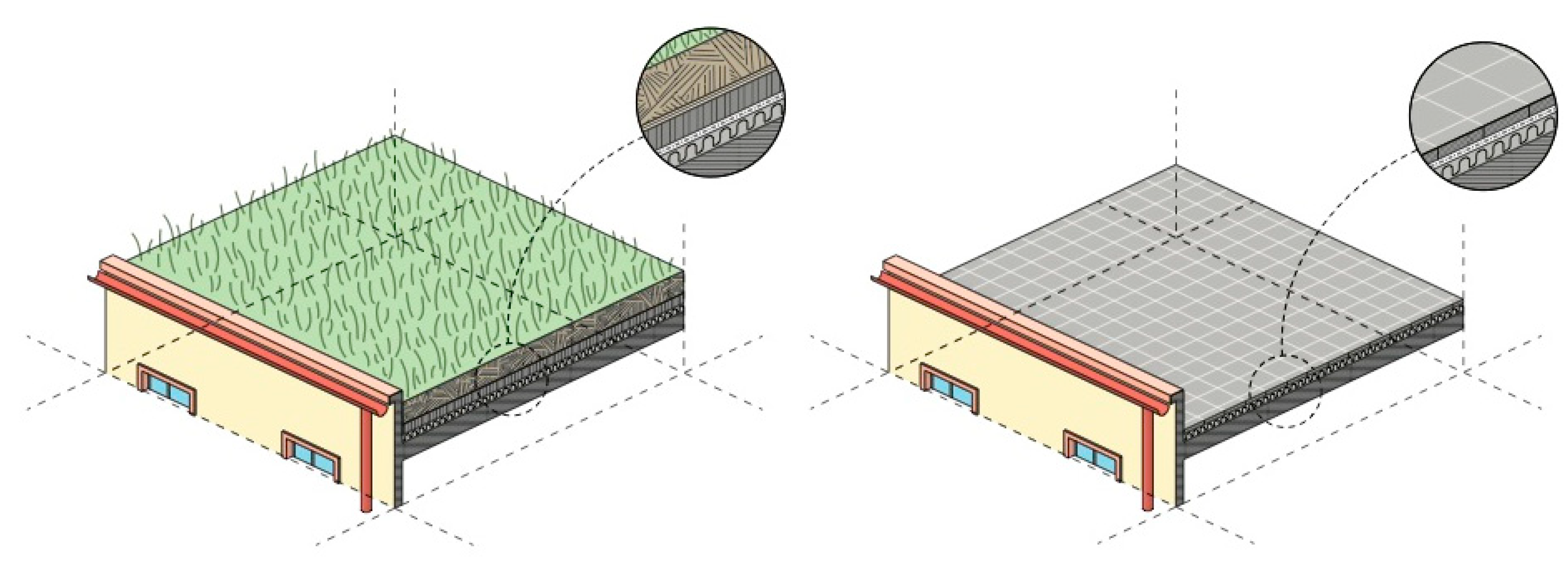
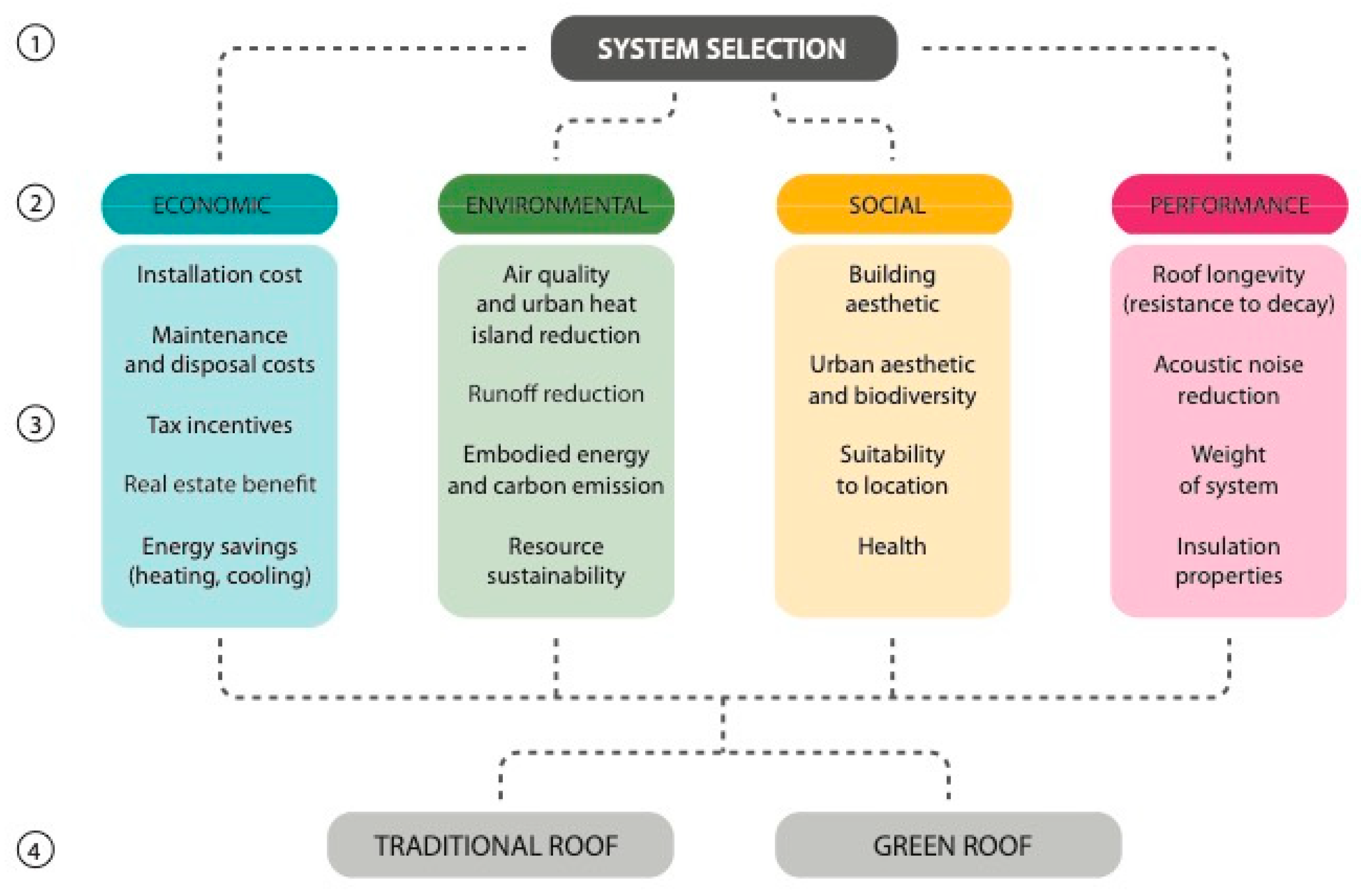
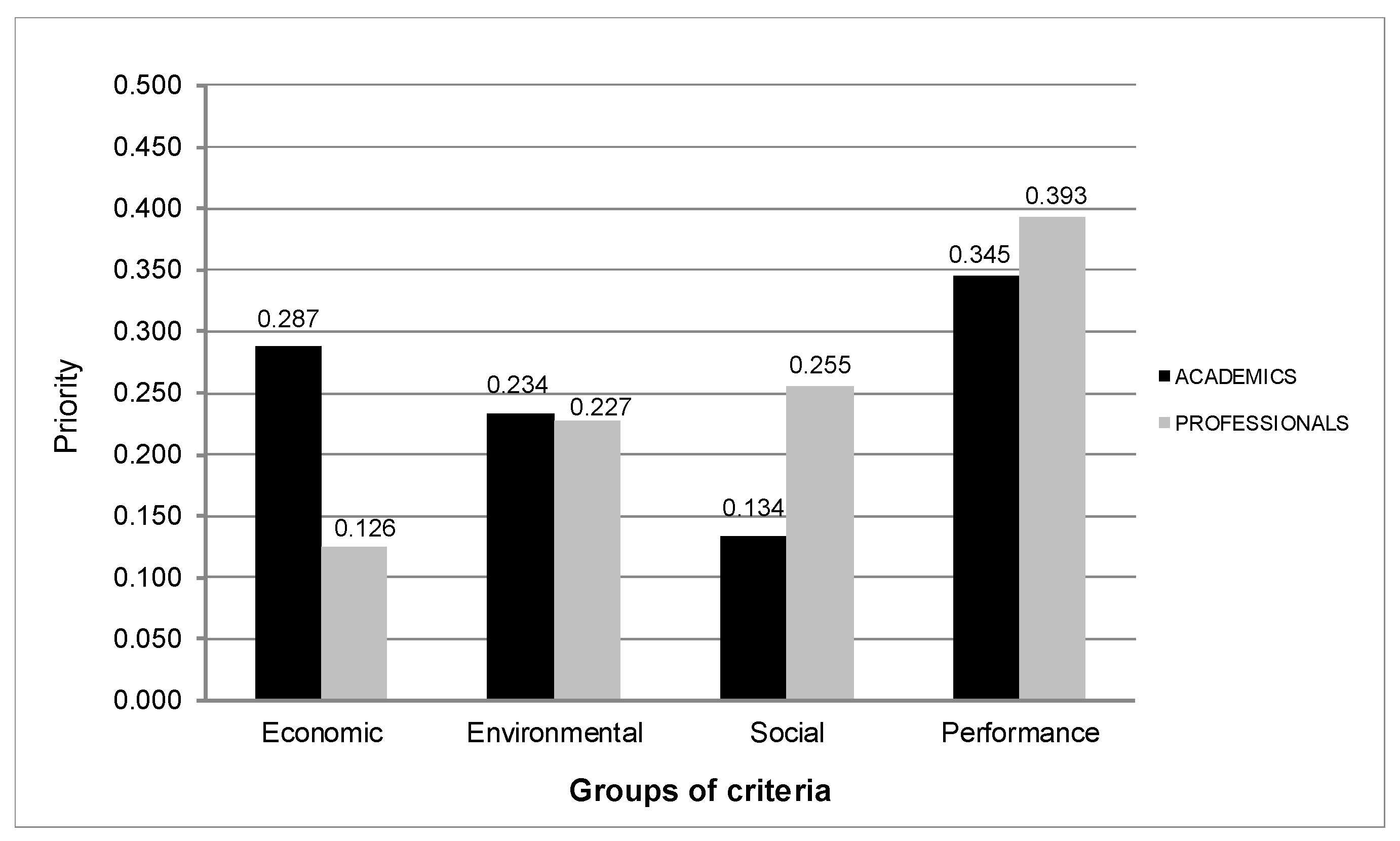
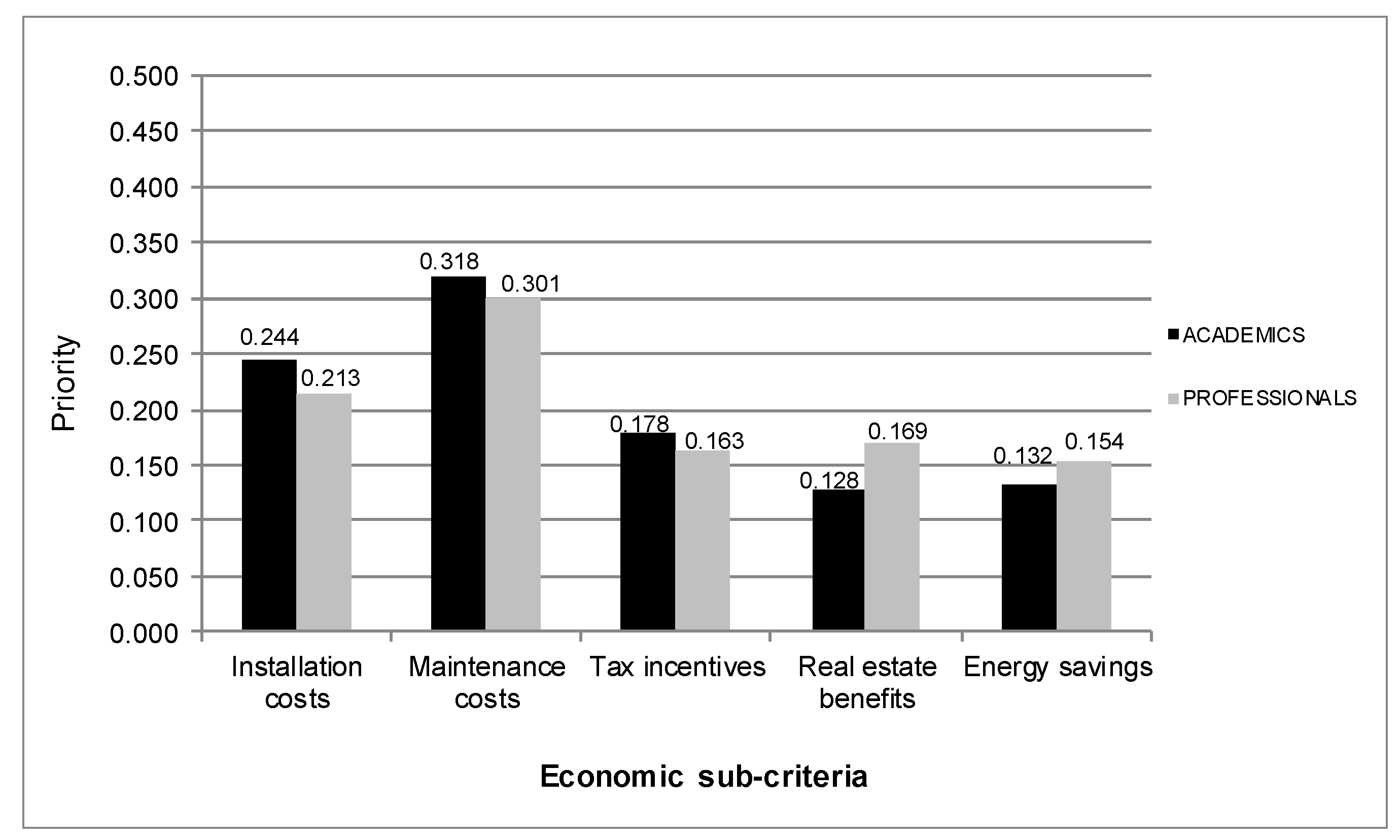
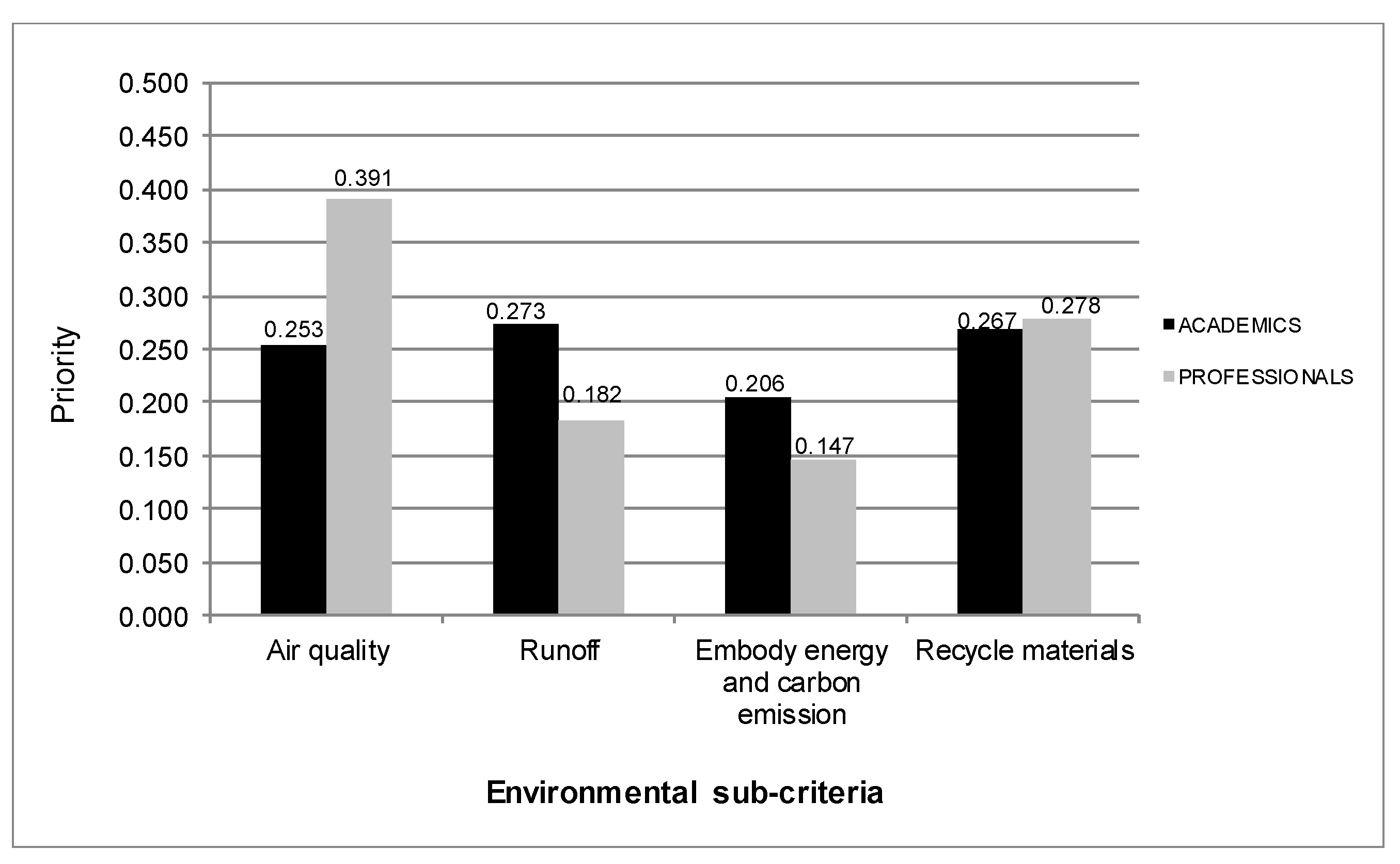
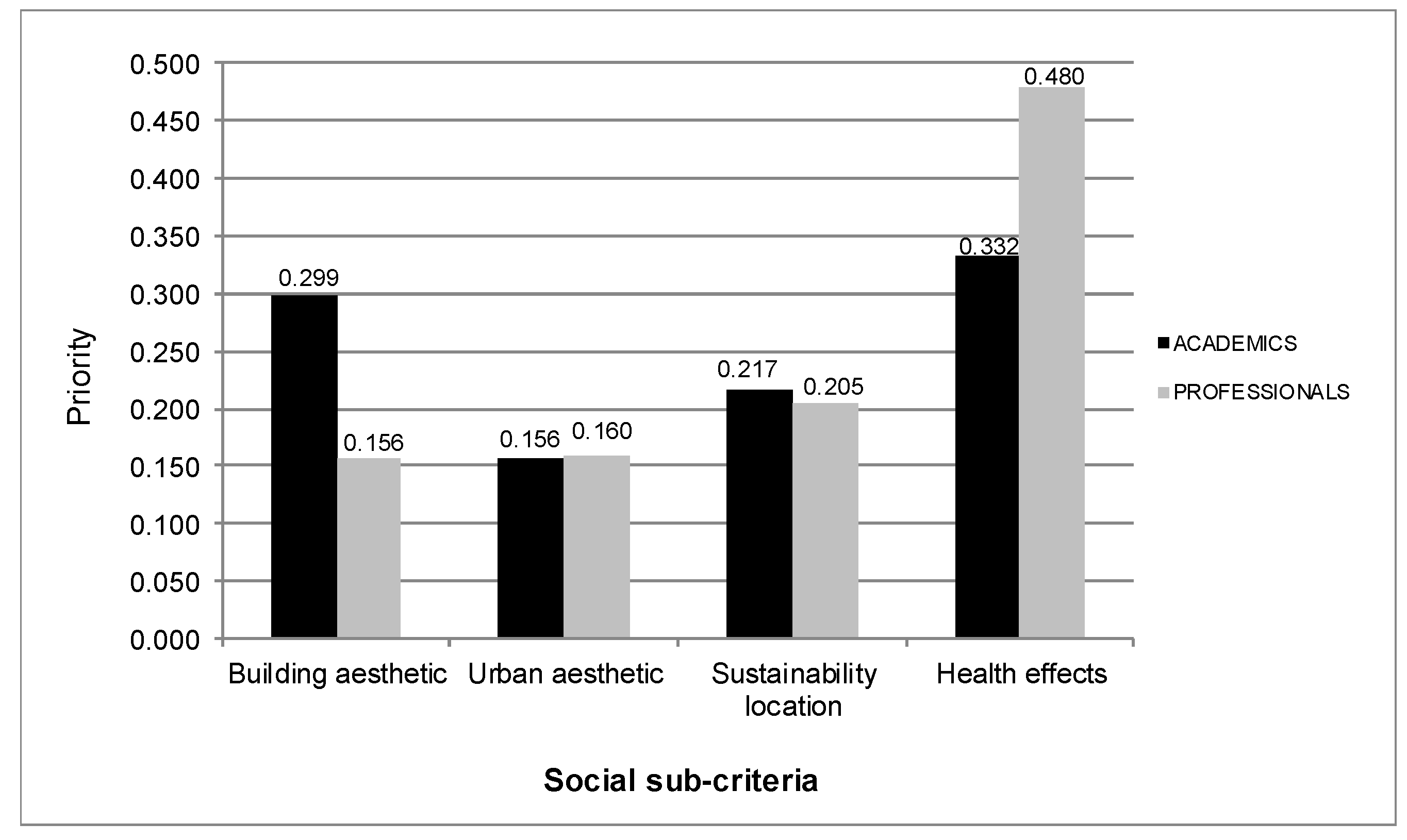
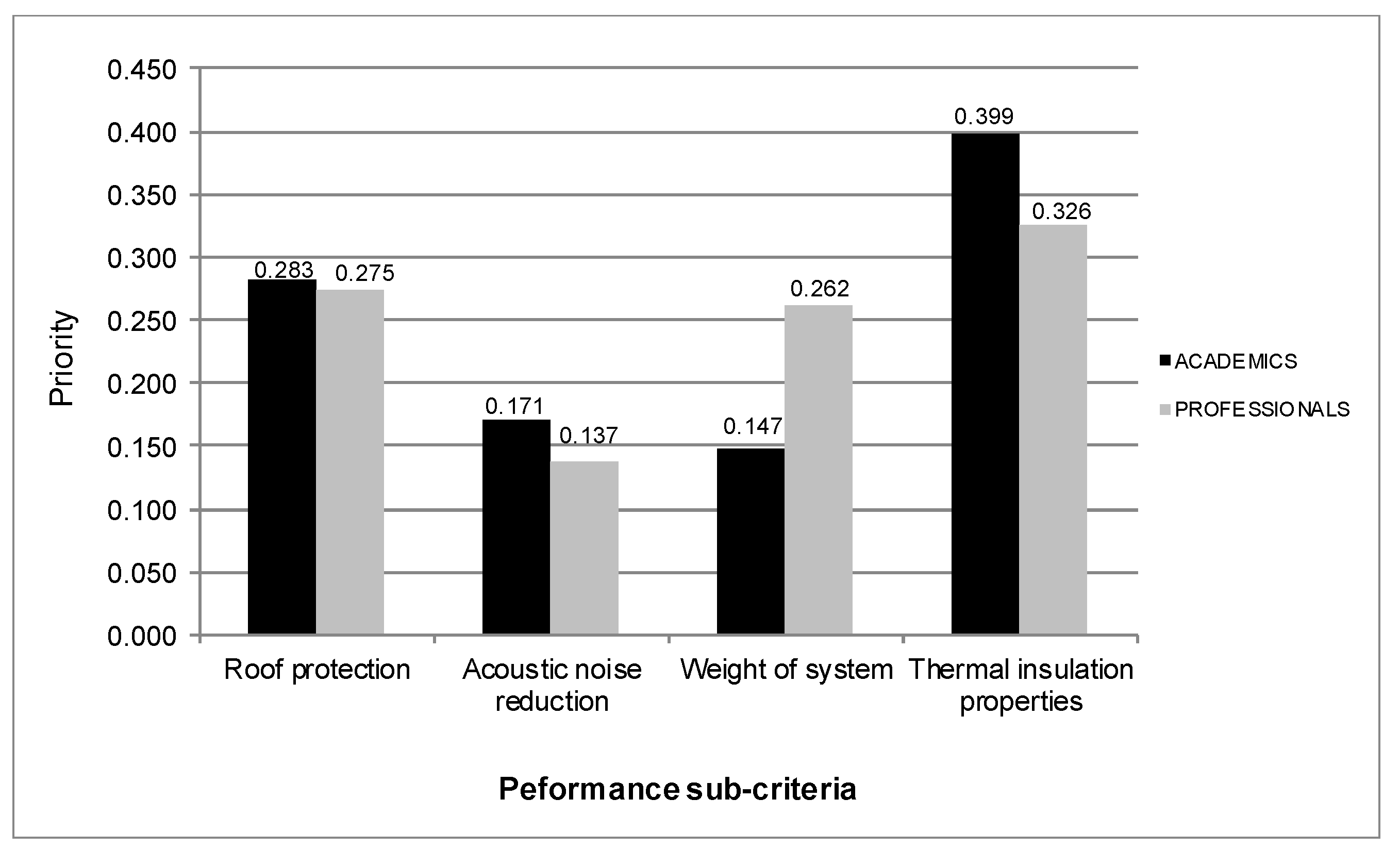
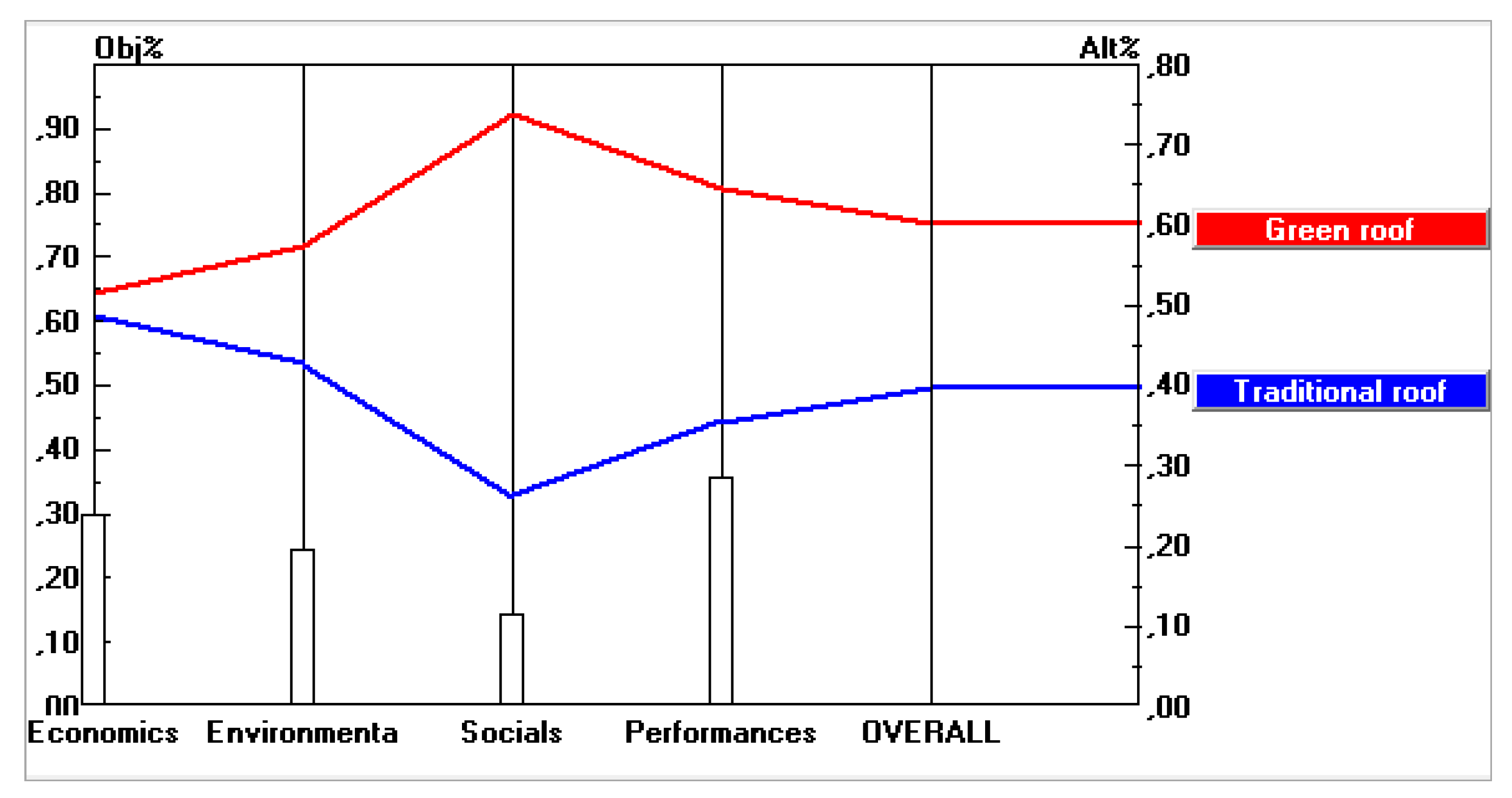
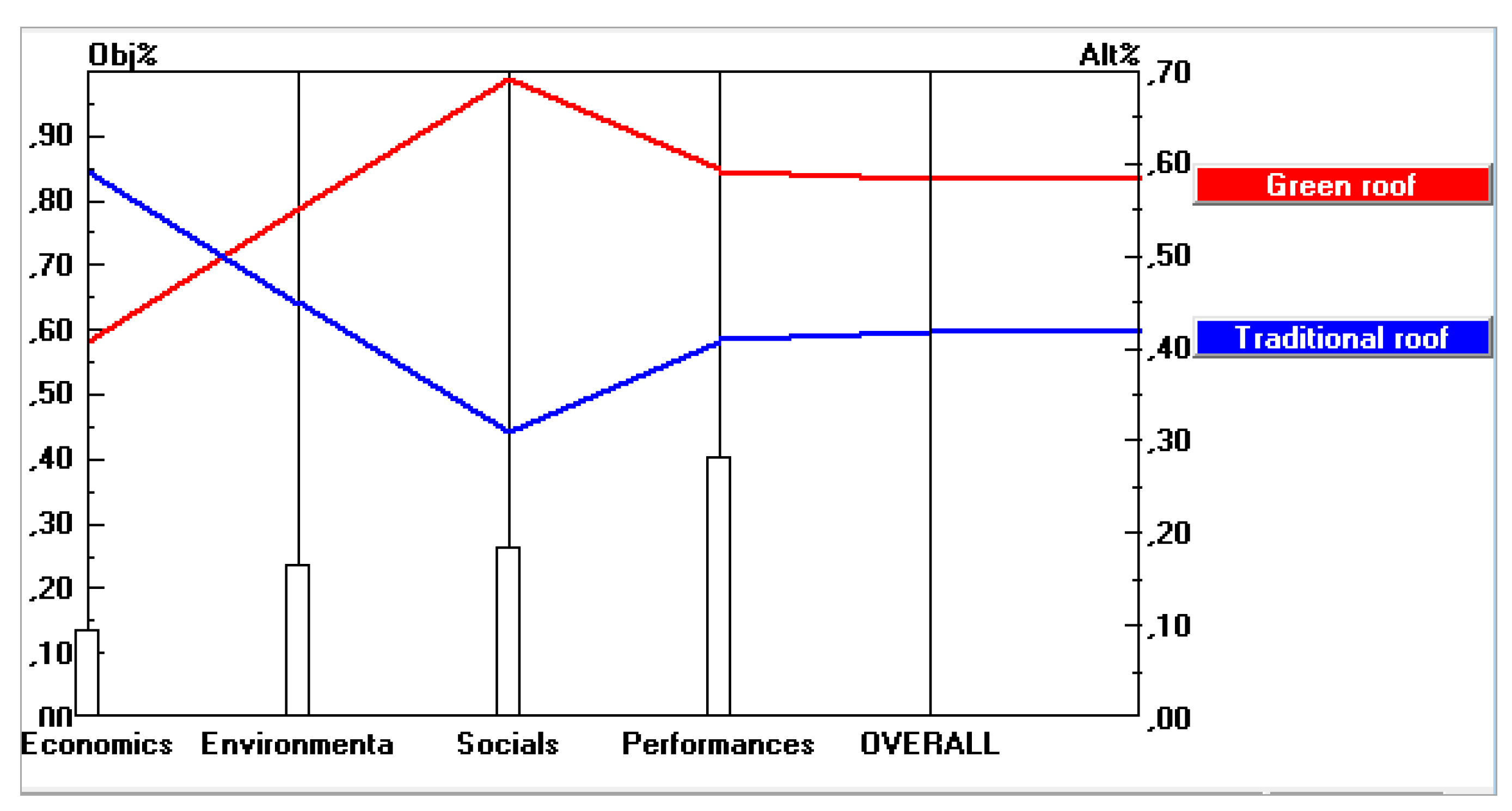
| Panel | Number of Components |
|---|---|
| Group a: Academics * | 15 |
| Group b: Professionals ** | 15 |
| Economic | Environmental | Social | Performance |
|---|---|---|---|
| Installation cost | Air quality and heat island reduction | Building aesthetic | Roof longevity |
| Maintenance and disposal costs | Runoff reduction | Urban aesthetic and biodiversity | Acoustic noise reduction |
| Tax incentives | Embodied energy and carbon emission | Suitability to location | Weight of system |
| Real estate benefit | Resource sustainability | Health | Insulation properties |
| Energy savings (heating, cooling) |
| Criterion 1 | Criterion 2 | Criterion 3 | Criterion 4 | |
|---|---|---|---|---|
| Criterion 1 | 1 | a12 | a13 | a14 |
| Criterion 2 | a21 | 1 | a23 | a24 |
| Criterion 3 | a31 | a32 | 1 | a34 |
| Criterion 4 | a41 | a42 | a43 | 1 |
| Groups of Criteria | Priority | Sub-Criteria | Priority within the Group * | Ranking within the Group * | Global Priority ** | Global Ranking ** |
|---|---|---|---|---|---|---|
| Economic | 0.206 | Installation costs | 0.229 | 2 | 0.047 | 10 |
| Maintenance costs | 0.309 | 1 | 0.064 | 6 | ||
| Tax incentives | 0.171 | 3 | 0.035 | 13 | ||
| Real estate benefit | 0.148 | 4 | 0.031 | 15 | ||
| Energy savings | 0.143 | 5 | 0.029 | 17 | ||
| Environmental | 0.230 | Air quality | 0.322 | 1 | 0.074 | 5 |
| Runoff | 0.228 | 3 | 0.053 | 8 | ||
| Embody energy and carbon emission | 0.176 | 4 | 0.041 | 11 | ||
| Recycle materials | 0,273 | 2 | 0.063 | 7 | ||
| Social | 0.194 | Building aesthetic | 0,156 | 4 | 0.030 | 16 |
| Urban aesthetic | 0,160 | 3 | 0.031 | 14 | ||
| Sustainability location | 0.205 | 2 | 0.040 | 12 | ||
| Health effects | 0.480 | 1 | 0,093 | 4 | ||
| Performance | 0.369 | Roof protection | 0.275 | 2 | 0.101 | 2 |
| Acoustic noise reduction | 0.137 | 4 | 0.051 | 9 | ||
| Weight of system | 0.262 | 3 | 0.097 | 3 | ||
| Thermal insulation properties | 0.326 | 1 | 0.120 | 1 |
| Panel Group | Traditional Roof | Green Roof | Difference |
|---|---|---|---|
| Academics | 0.398 | 0.602 | 0.204 |
| Professionals | 0.417 | 0.583 | 0.166 |
© 2019 by the authors. Licensee MDPI, Basel, Switzerland. This article is an open access article distributed under the terms and conditions of the Creative Commons Attribution (CC BY) license (http://creativecommons.org/licenses/by/4.0/).
Share and Cite
Rosasco, P.; Perini, K. Selection of (Green) Roof Systems: A Sustainability-Based Multi-Criteria Analysis. Buildings 2019, 9, 134. https://doi.org/10.3390/buildings9050134
Rosasco P, Perini K. Selection of (Green) Roof Systems: A Sustainability-Based Multi-Criteria Analysis. Buildings. 2019; 9(5):134. https://doi.org/10.3390/buildings9050134
Chicago/Turabian StyleRosasco, Paolo, and Katia Perini. 2019. "Selection of (Green) Roof Systems: A Sustainability-Based Multi-Criteria Analysis" Buildings 9, no. 5: 134. https://doi.org/10.3390/buildings9050134
APA StyleRosasco, P., & Perini, K. (2019). Selection of (Green) Roof Systems: A Sustainability-Based Multi-Criteria Analysis. Buildings, 9(5), 134. https://doi.org/10.3390/buildings9050134





